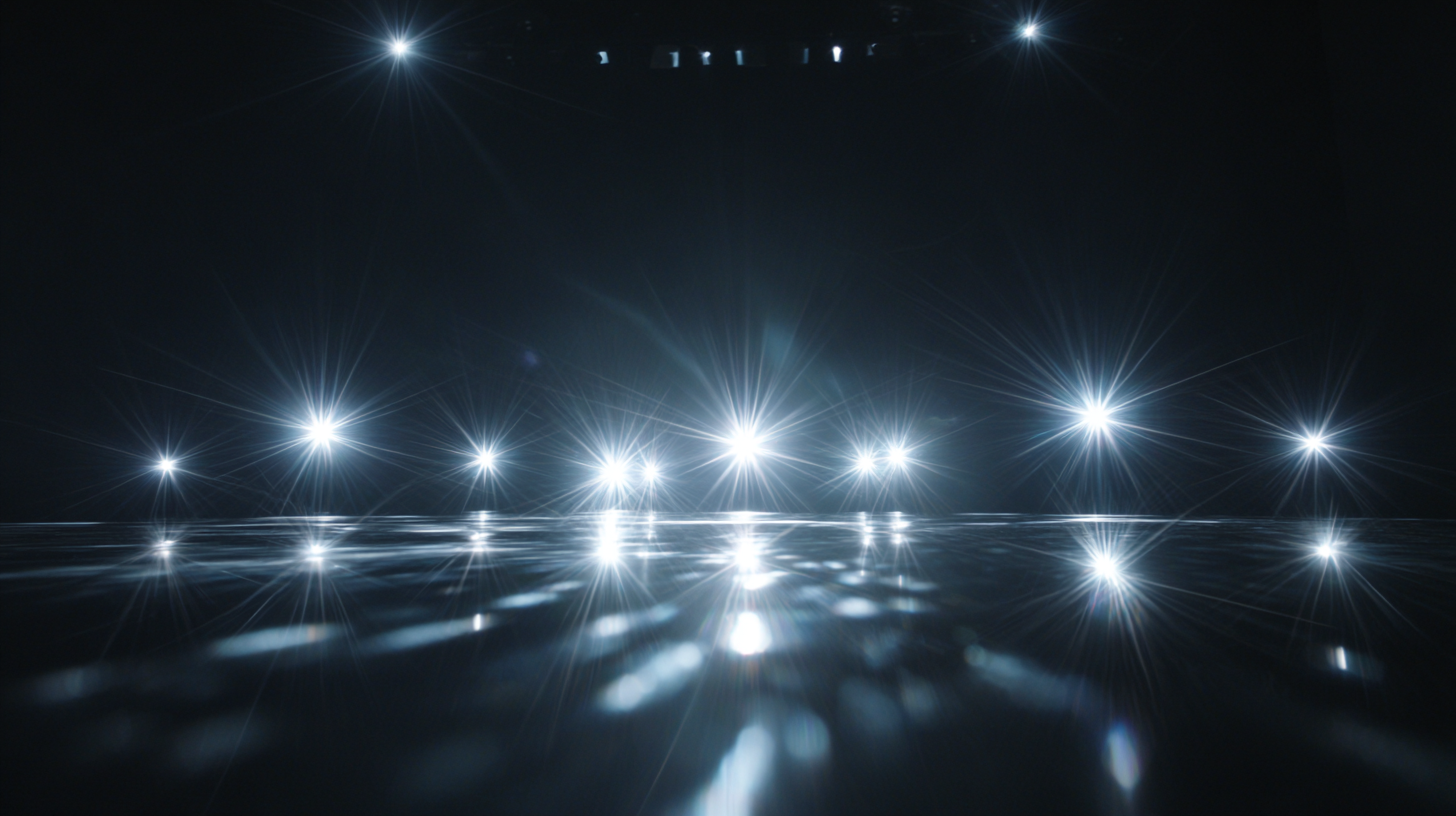Global Market Insights: The Future of Best LED Spotlights and Trends By 2025
In recent years, LED spotlights have gained significant traction in various lighting applications, revolutionizing how we illuminate our spaces. As we look towards 2025, understanding the future of LED spotlights becomes paramount, not just for manufacturers but also for consumers seeking energy-efficient and innovative lighting solutions.

This blog will delve into the emerging trends and driving factors that are shaping the LED spotlight market, highlighting why these products are becoming increasingly indispensable. With advancements in technology, sustainability concerns, and changing consumer preferences, the landscape of LED spotlights is set to evolve dramatically.
Join us as we explore the reasons behind this growth and what the future holds for these versatile lighting options.
Key Features of the Best LED Spotlights to Look For by 2025
As the demand for energy-efficient lighting continues to rise, the spotlight on LED technology is brighter than ever. By 2025, key features of the best LED spotlights will include enhanced energy efficiency, improved color rendering index (CRI), and smart technology integration. According to a recent report by Allied Market Research, the global LED lighting market is expected to reach $146.86 billion by 2025, with a compound annual growth rate (CAGR) of 13.9%. This growth is largely fueled by advancements in LED efficiency and affordability, making high-quality spotlights more accessible for both residential and commercial use.
In addition to energy savings and performance, consumers will increasingly seek LED spotlights that offer longevity and durability. The average lifespan of LED lighting can be up to 25,000 hours, significantly outpacing traditional lighting solutions. Furthermore, with technology trends pushing towards connectivity, smart LED spotlights that can be controlled via smartphones or home automation systems will become a standard feature. A report by Markets and Markets projects that the smart lighting market will grow to $24.31 billion by 2025, emphasizing that incorporating intelligent features will be critical for manufacturers aiming to capture market share. Buyers will be looking for products that not only illuminate spaces effectively but also integrate seamlessly into the smart homes of the future.
Emerging Trends in LED Technology and Their Impact on Spotlight Design
The LED spotlight market is experiencing rapid transformation, driven by advancements in technology and evolving consumer preferences. According to a recent report by MarketsandMarkets, the global LED spotlight market is projected to reach USD 10.14 billion by 2025, with a compound annual growth rate (CAGR) of 9.7% from 2020 to 2025. This growth underscores the increasing adoption of energy-efficient lighting solutions that reduce carbon footprints while maintaining high-quality illumination.

Emerging trends such as smart lighting integration and improved thermal management technologies are reshaping spotlight design. Innovations in wireless connectivity, like Wi-Fi and Bluetooth features, are allowing consumers to manage their lighting via mobile apps, enhancing user experience and convenience. Furthermore, advancements in heat dissipation techniques are increasing the lifespan and reliability of LED spotlights, making them a more attractive option for both residential and commercial applications. As manufacturers continue to focus on sustainability and user-centric designs, we can expect the next generation of LED spotlights to not only be energy efficient but also seamlessly integrated into our smart homes and workplaces.
Sustainability and Energy Efficiency: The Future of LED Spotlights
As the world increasingly prioritizes sustainability and energy efficiency, the future of LED spotlights is set to evolve dramatically by 2025. Energy-efficient lighting solutions are no longer just a trend; they have become essential for reducing environmental impact and lowering energy costs. LED spotlights, with their longevity and reduced energy consumption, offer an ideal pathway for both residential and commercial spaces aiming for a greener future.
Incorporating advanced technologies such as smart controls and connectivity features, these spotlights are becoming more versatile. Not only do they enhance ambiance and safety, but they also allow users to monitor and adjust energy usage in real-time. Moreover, manufacturers are focusing on eco-friendly materials and recyclable components, aligning their products with global sustainability goals. This transformation signifies a critical shift towards a more responsible approach to lighting, ensuring that LED spotlights will play a pivotal role in the quest for energy efficiency and environmental stewardship in the coming years.

Market Analysis: Consumer Preferences and Demand for LED Spotlights
The LED spotlight market is poised for significant evolution, driven by shifting consumer preferences and increasing demand across various sectors, including home appliances, food, and chemical industries. According to industry analysis, the global lighting market is expected to be valued at approximately $83.6 billion by 2024, with a projected compound annual growth rate (CAGR) of over 4.2% from 2025 to 2034. This growth is largely attributed to advancements in lighting technology, indicating a robust future for LED solutions.
Particularly noteworthy is the LED lighting market, which is forecasted to reach a valuation of around $94.5 billion by 2024. The application of LED lights in automotive lighting is expanding quickly, contributing to an anticipated CAGR exceeding 10.4% from 2025 to 2034. These statistics highlight the growing consumer preference for energy-efficient lighting alternatives and the versatile applications of LED technology across different industries. As businesses adapt to these trends, the focus on innovative LED products is likely to reshape market dynamics in the coming years.
Global Market Insights: Future of LED Spotlights by 2025
This chart illustrates the projected consumer demand for LED spotlights from 2021 to 2025. As indicated, there is a significant increase in demand, highlighting a trend towards more energy-efficient lighting options.
Innovative Applications of LED Spotlights Across Various Industries
The global LED spotlight market is evolving rapidly, driven by innovative applications across various industries. As we move closer to 2025, the demand for LED technology is expected to grow significantly, fueled by urbanization and rising disposable incomes. Reports forecast that the LED neon light market alone will expand from $1.3 billion in 2024 to over $3.3 billion by 2037, reflecting a compound annual growth rate (CAGR) of approximately 7.5% during this period. This growth will be primarily supported by advancements in LED technology and increased adoption in commercial, sports, and entertainment venues as they recover from the pandemic fallout.
In 2025, the LED display industry is set to face a dual dynamic of "innovation-driven growth" and heightened competition amid product homogenization. Major companies are channeling resources into breakthroughs in underlying technologies to establish robust competitive barriers. As new stage and commercial environments re-emerge, these innovations are expected to enhance performance, increase luminescence efficiency, and reduce energy consumption, thus reinforcing the strategic importance of LED spotlights across multiple sectors. The collaboration between industry leaders and ongoing investment in research and development will play a crucial role in shaping the future landscape of LED applications.
Global Market Insights: The Future of Best LED Spotlights and Trends By 2025
| Application Area | Market Size (Million USD) | Growth Rate (CAGR %) | Key Trends |
|---|---|---|---|
| Residential Lighting | 4500 | 8.5 | Smart Home Integration |
| Commercial Spaces | 3200 | 7.2 | Energy Efficiency |
| Industrial Applications | 2900 | 7.5 | Automated Lighting Systems |
| Outdoor Lighting | 2000 | 6.8 | Smart City Initiatives |
| Healthcare Facilities | 1500 | 6.1 | Hygiene and Safety Standards |
